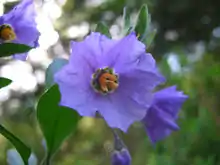Solanum xanti
Solanum xanti, known commonly as chaparral nightshade,[1] purple nightshade, and San Diego nightshade, is a member of the genus Solanum. It is native to the Western United States in Arizona, California, Nevada, and Oregon, and to northwest Mexico in Baja California.[2]
| Solanum xanti | |
|---|---|
 | |
| Scientific classification | |
| Kingdom: | Plantae |
| Clade: | Tracheophytes |
| Clade: | Angiosperms |
| Clade: | Eudicots |
| Clade: | Asterids |
| Order: | Solanales |
| Family: | Solanaceae |
| Genus: | Solanum |
| Species: | S. xanti |
| Binomial name | |
| Solanum xanti | |
The plant grows in chaparral, oak woodlands, conifer forests, desert Madrean Sky Islands, and other habitats.[3]
Description
Solanum xanti is a perennial herb or subshrub producing a branching hairy stem up to about 90 centimetres (35 in) in maximum height. The leaves are up to 7 centimeters long and are lance-shaped to oval, mostly unlobed except for occasional lobes at the bases of the blades.
It flowers from February to June in the wild, bearing an umbel-shaped inflorescence with many purple-blue flowers up to 3 centimeters wide. The fruit is a green berry 1 to 1.5 centimeters wide.[2]
Varieties
Varieties of the species include:
- Solanum xanti var. glabrescens — (endemic to California) [4]
- Solanum xanti var. hoffmannii — Hoffmann's nightshade (endemic to California) [5]
- Solanum xanti var. intermedium — (endemic to California) [6]
- Solanum xanti var. montanum [7]
- Solanum xanti var. obispoense — San Luis Obispo nightshade (endemic to California) [8]
- Solanum xanti var. xanti [9]
Cultivation
The plant is cultivated as an ornamental plant by specialty plant nurseries for planting in perennial border, drought-tolerant and native plant gardens. It grows from sunny locations to dry shade, such as under native oaks.[10][11][12]
The plant is deer resistant, due to its toxic qualities. In common with many other members in the Solanaceace family, all parts of the plant are toxic, especially the unripe fruit. Toxicity is from Solanine and glycol-alkaloids, chaconine, and solasodine. There is no antidote for Solanum poisoning. Symptoms include:
- Cardiovascular system (tachycardia, arrhythmia, and hypotension)
- Central nervous system (delirium, psychomotor, agitation, paralysis, coma, and convulsion)
- Gastrointestinal track (nausea, vomiting, diarrhea)[13]
- Selections
Cultivars and varieties available include:
References
- "Solanum xanti". Natural Resources Conservation Service PLANTS Database. USDA. Retrieved 17 November 2015.
- Jepson . accessed 1.27.2013
- Calflora database: Solanum xanti . accessed 1.27.2013
- USDA Plants profile: Solanum xanti var. glabrescens
- USDA Plants profile: Solanum xanti var. glabrescens
- USDA Plants profile: Solanum xanti var. intermedium
- USDA Plants profile: Solanum xanti var. montanum
- USDA Plants profile: Solanum xanti var. obispoense
- USDA Plants profile: Solanum xanti var. xanti
- CNPLX—California Native Plant Link Exchange: Solanum xanti — Nursery and Seed Sources . accessed 1.27.2013
- Las Pilitas Nursery: Solanum xanti — horticulture . accessed 1.27.2013
- San Marcos Growers: Solanum xanti . accessed 1.27.2013
- http://edenbythebay.blogspot.com/2013/10/poison-gardens-purple-nightshade.html
- Las Pilitas Nursery: Solanum xanti hoffmannii
- San Marcos Growers: Solanum xanti 'Mountain Pride'
External links
![]() Media related to Solanum xanti at Wikimedia Commons
Media related to Solanum xanti at Wikimedia Commons